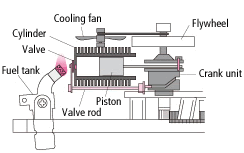Principles of the vacuum engine
This engine is a type of external combustion engine that has an external heat source. When heated air sucked into the cylinder is cooled inside it, a near vacuum state is created, which in turn moves the piston. Also, the opening/closing of the valve is synchronized with the piston by a crank mechanism. Additionally, the flywheel helps maintain stable rotation. Let's take a look at how the engine works. |
|
 |
 |
[1] When a valve moves and a hole opens, the piston moves toward the crank unit, sucking flame and heated air into the cylinder. |
 |
[2] When the piston moves all the way toward the crank unit (this is called the "bottom dead center"), the valve closes, and the air in the cylinder starts to cool. |
 |
[3] The cooled air contracts, creating a near vacuum state. As a result, the piston is sucked toward the valve. |
 |
[4] When the piston moves all the way toward the valve (this is called the "top dead center"), the hole opens. The contracted air inside the cylinder is expelled and at the same time the engine returns to the state in [1]. |
|
Amply provided with special features |
| |
◆ Continuously variable speed: Fully automatic
You can change gears with the clutch lever at the driver's seat. The gears are fully automatic and continuously variable. They are adjustable for low speeds that favor torque to high speeds that favor speed. Forward and reverse can both be operated by lever. |
◆ Removable engine unit
The engine components — flywheel, crank unit, piston, and cylinder — are unitized, so they can be removed. This allows you to install the engine to your handmade vehicles, like boats or locomotives. |
◆ Steering mechanism allows handle operation
The little steering wheel can actually be used to operate it. It is connected to the steering mechanism by a universal joint. Turn the steering wheel to change the travelling direction. |
◆ Suspension mechanism
The front wheels have a suspension mechanism. This prevents the rear wheels (the drive axle) from idling or coming off of the ground, regardless of road surface. |
|
|